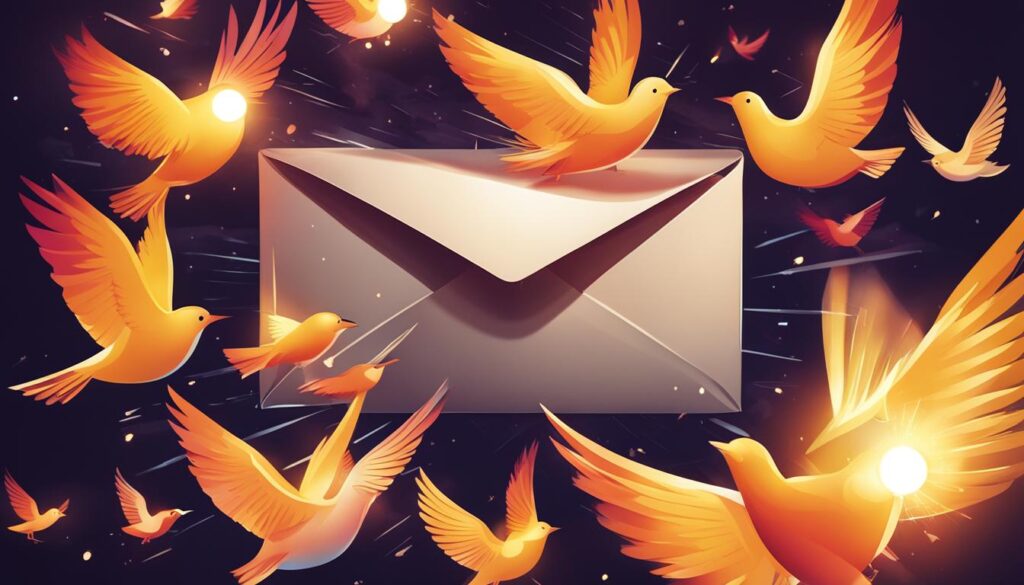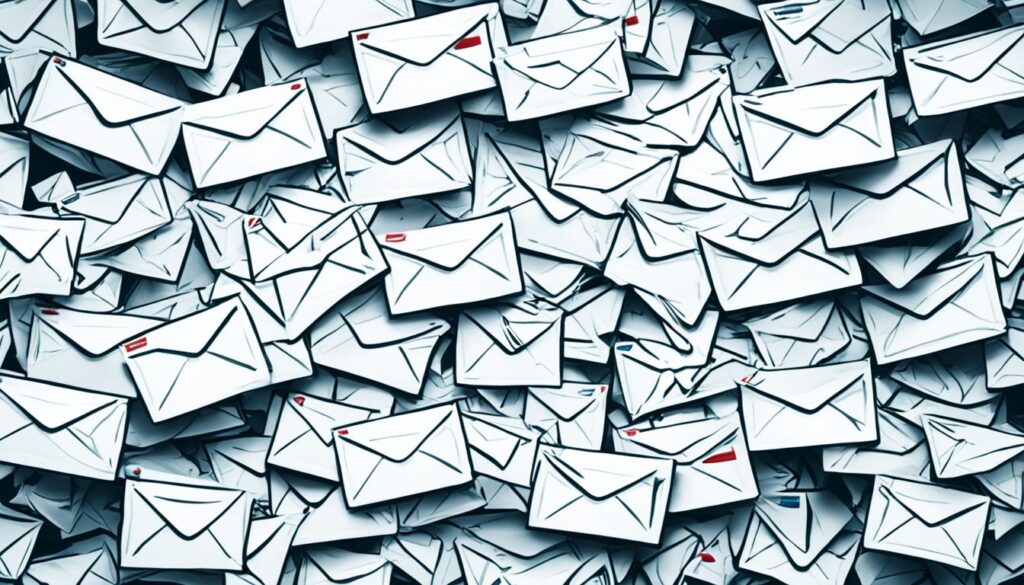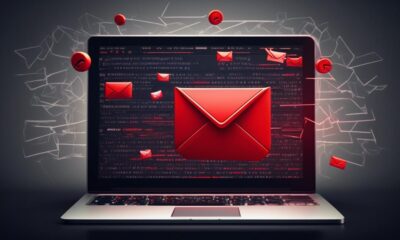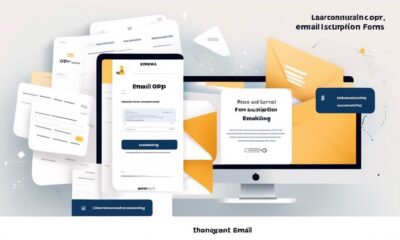Email Marketing
Email Marketing Missteps: Ways to Ruin Your Campaign

Are you aware that just one error in email marketing has the power to derail your whole campaign? Indeed, studies have indicated that minor mistakes within your email tactics can greatly influence your outcomes. Ranging from typical oversights to severe errors, numerous slip-ups could jeopardize the effectiveness of your email marketing strategies.
In this article, we will explore the most common email marketing mistakes and provide you with valuable insights on how to avoid them. By learning from these common missteps, you can take proactive steps to improve the effectiveness of your email campaigns and achieve greater success in reaching your audience.
So, let’s dive in and discover the key ways to ruin your email marketing campaign and how to steer clear of these pitfalls.
Key Takeaways:
- A single email marketing mistake can have a significant impact on your campaign’s success.
- Learning from common email marketing missteps can help you avoid pitfalls and improve your results.
- By implementing best practices and avoiding common blunders, you can enhance the effectiveness of your email campaigns.
- Stay tuned as we uncover the most common email marketing mistakes and provide actionable insights to help you achieve greater success.
Selling Too Hard
One of the biggest mistakes in email marketing is selling too hard. As a business, our goal is to foster a relationship with our customers and provide them with valuable content. Constantly pushing our products in every email can feel overwhelming and even annoying to recipients.
Instead, we need to find a balance between helpful content and product offers. By creating emails that provide value and address the needs and pain points of our customers, we can engage them in a way that feels genuine and helpful.
When crafting our email campaigns, we should aim to provide educational content, tips, and insights that align with our audience’s interests and challenges. By offering helpful information alongside product recommendations, we can establish trust and position ourselves as experts in our industry.
Avoid overwhelming our audience with constant sales pitches. Instead, focus on building a relationship by understanding their needs and offering solutions. Personalization is key here, as it allows us to tailor our content and offers to the specific interests and preferences of each recipient.
Fostering Relationships through Email
By fostering a relationship rather than solely focusing on sales, we can create a loyal customer base that trusts and values our brand. Here are a few strategies to help strike the right balance:
- Segment our email list based on customer preferences, interests, and purchase history. This enables us to send targeted and relevant content to each segment.
- Utilize storytelling in our emails to connect with our audience on a deeper level. Sharing personal experiences or success stories related to our products can help create an emotional connection.
- Include customer testimonials and reviews in our emails to build social proof and showcase the benefits and satisfaction of previous customers.
- Send personalized offers and discounts tailored to each recipient’s preferences and purchase history. This shows that we value their loyalty and understand their individual needs.
“The key to successful email marketing is not just promoting our products, but rather nurturing a relationship with our audience by providing them with valuable content and personalized offers that address their needs.” – Marketing Expert
By fostering a relationship with our audience through helpful content and personalized offers, we can create a positive perception of our brand and increase engagement and conversions. Remember, it’s not always about selling; it’s about building trust and delivering value to our customers.
Failing to Optimize for Mobile
With the increasing use of smartphones to read emails, it’s crucial to optimize your emails for mobile devices. Failing to do so can result in high delete rates and missed opportunities.
When it comes to mobile-friendly emails, there are a few key factors to consider:
Font Size:
Make sure that the font size used in your emails is legible on mobile devices. Text that is too small can lead to frustration and readers quickly deleting your message.
Graphics:
Graphics can greatly enhance the visual appeal of your emails, but they need to be optimized for mobile viewing. Large images can slow down load times, potentially causing recipients to lose interest and delete the email.
Flow of the Email:
The flow of your email should be easy to follow on a smaller screen. Avoid excessive scrolling or long paragraphs, and instead use shorter sections and bullet points to make the content more digestible.
“Optimizing your emails for mobile devices is essential to ensure that your message is accessible and visually appealing to your audience. By neglecting to do so, you risk losing potential customers and damaging your email campaign’s success.”
To illustrate the importance of mobile optimization, take a look at the data below:
Email Campaign Delete Rate Click-through Rate Conversion Rate Non-optimized for Mobile 30% 10% 5% Mobile-optimized 5% 20% 15%
As you can see, failing to optimize your emails for mobile devices can result in a significantly higher delete rate and lower click-through and conversion rates. By implementing mobile-friendly design practices, you can greatly improve the performance of your email marketing campaign.
Remember, mobile optimization is not just a “nice-to-have,” but a necessity in today’s digital landscape. Ensure that your emails are optimized for mobile devices to maximize engagement and drive better results.

Neglecting Your Sender Reputation
Your sender reputation plays a significant role in the success of your email campaigns. ISPs weigh factors like bounce rate and unsubscribe rate to determine your sender reputation score. Neglecting your sender reputation can lead to increased spam rates and decreased deliverability. Monitoring and improving your sender reputation is essential for successful email marketing.
When your sender reputation is compromised, it undermines the effectiveness of your email campaigns. ISPs use various metrics to evaluate the quality of your emails and determine whether to deliver them to recipients’ inboxes or mark them as spam.
One crucial factor ISPs consider is the bounce rate, which measures the percentage of email addresses that did not receive your messages due to invalid or inactive addresses. A high bounce rate indicates poor data hygiene and can negatively impact your sender reputation.
Another factor is the unsubscribe rate, which reflects the number of recipients who opted out of receiving your emails. A high unsubscribe rate suggests that your content is not meeting the expectations of your audience or that you are sending too many irrelevant emails, which can lead to a negative sender reputation.
Having a poor sender reputation can result in your emails being flagged as spam, making it increasingly challenging to reach your subscribers’ inboxes. This can severely impact your email deliverability rates, reducing the effectiveness of your campaigns and hindering your ability to connect with your audience.
Improving your sender reputation involves adopting best practices and actively managing your email list. Monitor your bounce and unsubscribe rates regularly and take appropriate action to rectify any issues. Ensure that you are only sending emails to engaged and interested recipients by implementing permission-based opt-in practices.
Additionally, regularly review and update your email list to remove inactive or disengaged subscribers. By maintaining a clean and engaged email list, you can improve your sender reputation and increase the likelihood of reaching your audience’s inboxes.
The Role of Authentication and Authentication Protocols
Implementing authentication protocols like SPF (Sender Policy Framework), DKIM (DomainKeys Identified Mail), and DMARC (Domain-based Message Authentication, Reporting, and Conformance) can significantly boost your sender reputation.
Authentication protocols verify the authenticity of your email and help ISPs trust your messages. SPF ensures that your emails are sent from authorized servers, while DKIM adds a digital signature to your messages to verify their integrity. DMARC combines SPF and DKIM to further enhance email authentication and provides reporting capabilities.
By implementing these authentication protocols, you can safeguard your sender reputation and improve your email deliverability rates.
Your Sender Reputation: Key Takeaways
- Neglecting your sender reputation can result in increased spam rates and decreased deliverability.
- ISPs assess your sender reputation based on factors like bounce rate and unsubscribe rate.
- Regularly monitor and address issues with bounce and unsubscribe rates to maintain a positive sender reputation.
- Implement authentication protocols like SPF, DKIM, and DMARC to enhance your sender reputation and improve email deliverability.

Avoiding Customer Segmentation
One-size-fits-all emails are not effective in email marketing. Avoiding customer segmentation is a common mistake that can result in irrelevant content and disengaged customers.
By targeting your audience and utilizing customer segmentation techniques, you can deliver personalized emails that resonate with your customers. Segmentation involves dividing your email list into specific groups based on factors like demographics, purchasing habits, and engagement levels. This allows you to tailor your content and offers to meet the unique needs and preferences of each segment.
Customer segmentation not only helps improve the relevance of your emails but also increases open rates, click-through rates, and conversions. By delivering relevant content and offers to specific segments, you demonstrate that you understand and value your customers’ needs, enhancing their overall experience.
Incorporating customer segmentation techniques such as behavioral segmentation, demographic segmentation, and geographic segmentation enables you to send targeted emails that resonate with different segments of your audience. By analyzing data and understanding your customers’ preferences, you can create highly personalized email campaigns that foster stronger connections and drive better results.

To illustrate the benefits of customer segmentation, consider the following example:
Failing to Include Clear Calls to Action
In email marketing, it’s crucial to include clear calls to action (CTAs) in your emails. CTAs tell your recipients what action you want them to take, whether it’s making a purchase, signing up for a webinar, or subscribing to a newsletter. Failing to include clear CTAs can lead to confusion and disengagement from your audience.
When creating CTAs, it’s important to be specific and concise. Use actionable language that encourages your recipients to take immediate action. For example, instead of saying “Learn more,” try saying “Click here to learn how our product can solve your problem.” This provides a clear direction and creates a sense of urgency.
Additionally, it’s crucial to make the action easy to complete. Use prominent buttons or hyperlinks that stand out in your email design. Ensure that the link or button is easily clickable on both desktop and mobile devices, as more and more people are accessing emails on their smartphones.
Another effective strategy is to focus on one CTA per email. This prevents overwhelming your recipients with multiple options and allows them to focus on the most important action you want them to take. Keep in mind that simplicity is key when it comes to CTAs.

“Including clear calls to action in your emails is essential for guiding your recipients and encouraging them to take the desired action. Don’t leave them guessing what to do next!”
GDPR Considerations
When it comes to email marketing, GDPR considerations are paramount. The General Data Protection Regulation (GDPR) introduced strict guidelines and regulations for businesses handling personal data of individuals in the European Union. Although GDPR may not be legally required in the United States, it’s important to take compliance and data protection seriously to maintain trust with your subscribers and avoid potential legal issues.
One important GDPR consideration for email marketing is implementing an opt-in feature. By providing an opt-in option, you give individuals control over their personal data and ensure that you have their explicit consent to send them marketing emails.
Failure to comply with GDPR regulations can result in severe consequences, including being marked as spam by email service providers and facing legal penalties. It’s crucial to familiarize yourself with the legal guidelines and ensure that your email marketing practices align with GDPR requirements, even if you primarily target a U.S. audience.

Neglecting Analytics
Analytics are a vital component of a successful email marketing campaign. Neglecting to track and analyze email marketing metrics can limit our ability to optimize our strategy and achieve better results. By monitoring key metrics such as open rate, click-through rate, subscriber growth, and unsubscribe rate, we can gain valuable insights into the effectiveness of our campaigns and make informed decisions.
Analytics provide us with the data we need to identify trends, measure engagement, and assess the overall performance of our email marketing efforts. By understanding how our subscribers are interacting with our emails, we can refine our content, targeting, and messaging to better meet their needs and expectations.
“Without measuring our email marketing metrics, we’re essentially flying blind. Analytics help us understand what’s working, what’s not, and where we can make improvements.”
For example, tracking the open rate can give us insights into the effectiveness of our subject lines and preview text. If we notice a low open rate, it may indicate that our subject lines are not compelling enough or that our emails are not reaching the inbox. By experimenting with different subject lines and monitoring the resulting open rates, we can optimize our email content to increase engagement.
Similarly, analyzing the click-through rate can help us understand how well our calls to action are resonating with our audience. If we find a low click-through rate, it may be an indication that our email content or CTA placement needs improvement. By testing different CTAs and monitoring the click-through rate, we can optimize our emails to drive more conversions and achieve our goals.
Optimizing Email Marketing Strategy with Analytics
By neglecting analytics, we miss out on valuable opportunities to optimize our email marketing strategy. Here are a few ways analytics can help us improve our campaigns:
- Identifying underperforming campaigns: Analyzing metrics allows us to identify email campaigns that are not meeting our goals. By pinpointing the areas that need improvement, we can make data-driven adjustments.
- Segmenting our audience: Analytics can help us identify different segments within our subscriber base. By segmenting our audience based on metrics such as engagement levels or purchase history, we can deliver more targeted and personalized emails.
- Testing and refining: Analytics enable us to test different elements of our emails, such as subject lines, calls to action, or email length. By comparing the performance of different versions, we can refine our emails for maximum effectiveness.
Don’t let valuable data go to waste. Embrace analytics and leverage the insights they provide to optimize your email marketing campaigns and achieve better results.

Data Analysis: Open Rate, Click-through Rate, Subscriber Growth, and Unsubscribe Rate
To provide a deeper understanding of the importance of analytics in email marketing, let’s examine four key metrics: open rate, click-through rate, subscriber growth, and unsubscribe rate. The table below summarizes the significance of each metric and the insights it can offer:
Metric Significance Insights Open Rate Indicates the percentage of recipients who opened the email Effectiveness of subject lines and preview text
Inbox placement and deliverabilityClick-through Rate Measures the percentage of recipients who clicked on a link within the email Engagement with the email content
Effectiveness of call to action (CTA)Subscriber Growth Tracks the increase in the number of subscribers over a specific period Effectiveness of lead generation strategies
Subscriber acquisition and retentionUnsubscribe Rate Represents the percentage of subscribers who opted out of receiving emails Relevance and value of email content
Email frequency and cadence
Writing Poor Subject Lines
The subject line of an email is the first impression recipients have of your message. It’s often the deciding factor whether they open it or not. That’s why crafting engaging, concise, and relevant subject lines is essential for maximizing email open rates and avoiding missed opportunities.
When writing subject lines, it’s important to consider subject line best practices to capture the attention of your audience. Here are some tips to help you create compelling subject lines:
- Keep it concise: A subject line that is too long may get cut off, leaving recipients unsure of what the email is about. Aim for a length of around 40-50 characters for optimal visibility.
- Be clear and specific: Clearly communicate the purpose or content of the email in a way that resonates with your audience. Avoid vague statements that could confuse or mislead recipients.
- Personalize when possible: Including the recipient’s name or other personalized details can grab their attention and make the email feel more relevant and tailored to their needs.
- Create a sense of urgency: Using words and phrases like “limited time offer” or “act now” can create a sense of urgency and prompt recipients to open the email immediately.
- Ask a question: Pose a thought-provoking question that piques the recipient’s curiosity and makes them want to find out the answer within the email.
- Use numbers or statistics: Incorporate numbers or statistics in your subject lines to make them more specific and intriguing. For example, “5 proven strategies to improve open rates.”
By following subject line best practices and experimenting with different strategies, you can improve the effectiveness of your email marketing campaigns and increase engagement with your audience.
Remember, the subject line is your first chance to make an impression. Don’t waste this valuable opportunity with poor subject lines that fail to capture the attention of your recipients.
Examples of Engaging Subject Lines
| Subject Line | Description |
|---|---|
| “Get 50% off your next purchase” | A clear and enticing offer that creates a sense of urgency. |
| “Discover the secrets to successful email marketing” | Appeals to the recipient’s desire for knowledge and improvement. |
| “You’re invited: Join us for our exclusive webinar” | Makes the recipient feel special and offers valuable content. |
| “Free shipping on all orders this weekend only” | An enticing promotion that encourages immediate action. |
Remember, your subject lines have the power to determine whether your emails get opened or ignored. By implementing subject line best practices and crafting engaging, relevant subject lines, you can significantly improve your email open rates and drive more meaningful interactions with your audience.

Including Too Many Images
While images can enhance the visual appeal of your emails, it’s important to avoid using too many images, as it can create issues for your recipients. Some email clients may block images by default, resulting in a blank email for those recipients. This can negatively impact the email readability and overall user experience.
Instead, it’s best to use a few strategically placed images that are relevant to your email content. By selecting images that effectively convey your message, you can enhance the overall impact of your email without overwhelming your recipients.

When incorporating images, make sure they are properly spaced and aligned within your email. This will help maintain a clean and organized layout, ensuring that the focus remains on your content.
Additionally, consider the file size of your images. Large image files can significantly slow down the loading time of your email, leading to frustration for your recipients. Optimizing your email images by compressing them without compromising their quality can help ensure faster loading times and a smoother user experience.
By using images strategically, ensuring proper spacing, and optimizing their file sizes, you can create visually appealing emails that captivate your audience while maintaining a seamless email reading experience.
Not Having a Clear Purpose
Having a clear purpose is vital when it comes to email marketing goals. Without a specific goal in mind, our emails may lack focus and fail to deliver a clear message to our audience. It’s essential to align our purpose with our business goals to ensure that each email serves a purpose in achieving those goals.
Delivering a clear message is crucial for engaging our recipients and driving the desired action. By defining a clear purpose for each email, we can craft targeted and compelling content that resonates with our audience. Whether our goal is to promote a new product, share valuable information, or nurture customer relationships, a clear purpose will guide the content creation process and help us deliver meaningful messages.
When designing our email campaigns, we should ask ourselves: What do we want to achieve with this email? What action do we want our recipients to take? Answering these questions will help us develop a focused and impactful message that motivates our audience to take the desired action.
“A clear purpose guides the content creation process and helps deliver meaningful messages to our audience.”
Email Marketing Goals
To establish a clear purpose for our email marketing campaigns, we need to define our goals. Our goals may vary depending on our business objectives and the specific campaign we are running. Here are some common email marketing goals:
- Increasing sales and revenue
- Driving website traffic
- Building brand awareness
- Nurturing customer relationships
- Generating leads
Each goal requires a different approach and content strategy. By setting clear goals, we can tailor our emails to meet those objectives and achieve measurable results.
Delivering a Clear Message
To effectively deliver a clear message, we should consider the following strategies:
- Keep it concise: Be concise and to the point. Avoid overwhelming our audience with lengthy emails that may dilute the message.
- Highlight key points: Use bold and bullet points to emphasize important information, making it easily scannable for our recipients.
- Use compelling headlines: Craft attention-grabbing subject lines and headlines that clearly communicate the purpose of the email and entice recipients to open and read it.
- Personalize the content: Tailor the message to the recipient’s needs and preferences. Personalization can enhance engagement and make the email feel more relevant.
By having a clear purpose, setting specific goals, and delivering a concise and targeted message, we can enhance the effectiveness of our email marketing campaigns and achieve better results.

Conclusion
Email marketing can be a highly effective tool when executed properly. By avoiding common mistakes such as selling too hard, failing to optimize for mobile, neglecting your sender reputation, and avoiding customer segmentation, you can improve the success of your email campaigns.
To have a successful email marketing campaign, it’s crucial to always have a clear purpose for your emails. Each email should serve a specific goal and align with your business objectives. Additionally, including clear calls to action will guide your recipients on the desired actions to take, improving engagement and conversion rates.
Following email marketing best practices is essential to achieve success. Provide value to your recipients by delivering relevant and personalized content. Continuously analyze your results and make data-driven decisions to optimize your email campaigns. By combining these tips and techniques, you can achieve your email marketing goals and drive the success of your business.
Some common email campaign pitfalls include selling too hard, failing to optimize for mobile, neglecting your sender reputation, avoiding customer segmentation, and failing to include clear calls to action.
Selling too hard can lead to disengaged customers and lower open and conversion rates. It’s important to foster a relationship with your customers and provide them with helpful content instead of constantly pushing your products.
Optimizing emails for mobile devices is crucial because many people use smartphones to read emails. Neglecting to do so can result in high delete rates and missed opportunities. Neglecting your sender reputation can lead to increased spam rates and decreased deliverability. ISPs weigh factors like bounce rate and unsubscribe rate to determine your sender reputation score.
Customer segmentation allows you to deliver personalized and relevant emails to different segments of your audience. Neglecting customer segmentation can result in irrelevant content and disengaged customers.
Clear calls to action tell your recipients what you want them to do and increase engagement. Failing to include clear CTAs can lead to confusion and disengagement.
GDPR considerations include ensuring compliance with regulations, adding an opt-in feature to your email list, and respecting the legal guidelines for sending marketing emails.
Neglecting to track and analyze metrics like open rate, click-through rate, subscriber growth, and unsubscribe rate hinders your ability to improve your email marketing strategy and campaign effectiveness. Poor subject lines can result in low open rates and missed opportunities. Crafting engaging, concise, and relevant subject lines can increase your email open rates.
Including too many images can cause some recipients to block email images, resulting in a blank email. It’s important to strategically use a few images and optimize their file size for efficient loading times.
Having a clear purpose ensures that each email serves a specific goal and delivers a clear message. Without a clear purpose, your emails may lack focus and fail to engage your recipients.
By avoiding common email campaign pitfalls such as those mentioned above and following best practices, you can improve the success of your email marketing campaign. It’s essential to have a clear purpose, include clear calls to action, and provide value to your recipients.
FAQ
What are some common email campaign pitfalls?
How can selling too hard ruin an email campaign?
Why is it important to optimize emails for mobile devices?
How does neglecting sender reputation affect email campaigns?
Why is customer segmentation important in email marketing?
How can clear calls to action improve email campaigns?
What GDPR considerations should be made in email marketing?
Why is neglecting analytics a mistake in email marketing?
How can writing poor subject lines impact email campaigns?
What issues can arise from including too many images in emails?
Why is having a clear purpose important in email marketing campaigns?
How can I improve the success of my email marketing campaign?
Erik – Email, SEO, AI Expert Writer Erik is the strategist, the thinker, and the visionary. His role at Influenctor is pivotal in integrating SEO with AI-driven content strategies. With an extensive background in email marketing and a profound understanding of search engine algorithms, Erik develops innovative strategies that elevate our client’s online presence. His work ensures that our content is seen, felt, and remembered.
Personalized Email Strategies
Email Marketing for Home Inspectors
Stand out in the competitive home inspection industry with powerful email marketing strategies that will take your business to the next level.

Let’s face it – standing out in the competitive home inspection industry is like searching for a needle in a haystack. However, there is a successful tactic that allows us to cut through the noise and make a lasting impression: email marketing.
It’s not just about sending out generic newsletters; it’s about strategically nurturing relationships and staying top-of-mind with realtors who can be valuable sources of referrals.
But how do we effectively craft emails that resonate with our audience and drive results? Well, it all starts with understanding the benefits of email marketing for home inspectors and harnessing its potential to showcase our expertise, build trust, and ultimately grow our business.
Key Takeaways
- Email marketing allows home inspectors to reach a targeted audience and expand their reach through shareable content.
- Craft attention-grabbing subject lines and provide concise, valuable content that addresses recipients’ pain points to effectively engage with subscribers.
- Collaborate with other home inspection companies or real estate agents to grow your email list and offer valuable information to reach new potential subscribers.
- Personalize emails, use effective calls to action, and establish a strong online presence to maximize the impact of your email campaigns.
Benefits of Email Marketing
Email marketing offers a powerful way to reach a targeted audience and expand our reach through shareable content, making it a reliable and effective communication channel for home inspectors. With the ability to select a specific audience, we can ensure that our messages reach the right individuals, such as real estate agents and potential clients within the home inspection industry. Shareable content not only increases our reach but also helps in generating more leads, thereby broadening our audience and increasing brand awareness. The high usage of email ensures the delivery of our messages, making it a dependable tool for our marketing strategy.
Through email marketing campaigns, we can stay top-of-mind with industry professionals and potential clients, enhancing our visibility and credibility within the industry. It also serves as an effective tool for promoting events, announcements, and industry knowledge, providing us with a platform to showcase our expertise in home inspections. As we aim to establish a strong digital presence, email marketing proves to be an essential component of our overall marketing strategy, allowing us to communicate directly with our target audience and foster meaningful connections.
Effective Email Content

When crafting effective email content, we aim to personalize and target our messages to resonate with our specific audience. It’s crucial for home inspectors to tailor their email content to cater to the needs and interests of their real estate clients, agents, and home inspectors.
To achieve this, we focus on the following key strategies:
- Compelling Subject Lines and Valuable Content:
- Crafting attention-grabbing subject lines that entice recipients to open the email.
- Providing concise, valuable content that delivers relevant information and addresses the recipients’ pain points.
- Clear Calls-to-Action and Email Automation:
- Including clear calls-to-action in emails to prompt desired responses and actions from recipients.
- Utilizing email automation tools to streamline and enhance the efficiency of email marketing campaigns.
In the competitive landscape of the home inspection business, effective email content can serve as a powerful tool for engaging with real estate clients, nurturing relationships with agents, and fostering collaboration with fellow home inspectors. By implementing these strategies and continuously monitoring and analyzing email performance metrics, home inspectors can optimize their email content to drive successful home inspection marketing campaigns.
Growing Your Email List
To grow your email list effectively, we consistently seek out opportunities to engage with potential clients and expand our network of contacts in the real estate industry. One way to achieve this is by collaborating with other home inspection companies or real estate agents and home professionals. By offering to contribute a blog post or provide valuable information to their audience, we can reach new potential subscribers who are interested in our services.
Additionally, we use email as a tool to build trust and provide valuable information. When connecting with clients or industry professionals, we ensure that every interaction is an opportunity to showcase our expertise and the benefits of being part of our email list. By consistently delivering good email content, we can keep our subscribers engaged and build a positive reputation in the industry.
Another effective way of growing your email list is by encouraging satisfied clients to join our contact list and share their positive experiences with others. We also utilize social media platforms to promote our email list and engage with potential subscribers. By implementing these strategies, we can steadily expand our email list with high-quality leads and maintain a strong network of contacts in the real estate industry.
Maximizing Email Campaigns

As we aim to maximize the impact of our email marketing efforts, personalized communication and valuable content will continue to be the cornerstones of our strategy.
To ensure higher open rates and engagement, we’ve found that incorporating captivating content and exclusive offers is a great way to make our emails stand out.
Consider the following tips for home inspectors:
- Establish Strong Online Presence
- Engage with subscribers through personalized greetings and tailored recommendations based on their previous interactions with your website or services.
- Utilize segmentation to target specific groups with content relevant to their needs and interests.
- Incorporate Effective Call to Action
- Encourage recipients to take action by including clear and compelling calls to action that prompt them to explore your services or claim exclusive offers.
Avoiding Email Marketing Pitfalls
To successfully navigate the realm of email marketing, a thorough understanding of potential pitfalls is essential for home inspectors seeking to maintain a positive brand image and engage effectively with recipients. By avoiding common email marketing pitfalls, home inspectors can enhance their credibility, build strong relationships, and keep recipients engaged. Here are some key pitfalls to watch out for and how to steer clear of them:
| Pitfall | How to Avoid It |
|---|---|
| Ensure compliance with email marketing laws and regulations | Stay informed about the laws and regulations governing email marketing to avoid legal issues. |
| Avoid sending too many emails | Set a reasonable frequency for your emails to prevent overwhelming or annoying recipients. |
| Use a professional and clean email design | Create a visually appealing and easy-to-navigate email template to maintain a positive brand image. |
| Personalize emails and avoid generic content | Tailor your emails to the recipient’s needs and interests to enhance engagement and relevance. |
| Regularly clean and update email lists | Keep your contact information up to date and remove outdated or incorrect addresses to ensure your emails reach the right audience right away. |
Frequently Asked Questions
How Can Home Inspectors Ensure Their Email Marketing Campaigns Are Compliant With Privacy Laws and Regulations?
We ensure email marketing campaigns comply with privacy laws and regulations by staying informed about current legislation and regulations.
We regularly review and update our email lists to ensure they only include individuals who’ve opted in.
Our email content includes clear opt-out options and complies with requirements for data protection and privacy.
We also maintain records of consent and regularly audit our practices to ensure ongoing compliance with evolving regulations.
What Are Some Creative Ways Home Inspectors Can Segment Their Email Lists to Target Different Types of Clients?
Segmenting email lists for home inspectors can be a game-changer.
We can group clients based on property type, like condos or single-family homes, or by specific needs such as first-time buyers or investors.
This allows us to tailor our messages, providing relevant content to each group, increasing engagement and conversions.
Are There Any Specific Email Marketing Tools or Platforms That Are Recommended for Home Inspectors?
We’ve found that email marketing tools like Mailchimp, Constant Contact, and HubSpot are highly recommended for home inspectors. These platforms offer user-friendly interfaces, customizable templates, and robust analytics to track email performance.
They also provide features for segmenting email lists, automating campaigns, and integrating with other marketing tools.
How Can Home Inspectors Measure the Success of Their Email Marketing Campaigns and Track Their Return on Investment?
We measure the success of our email marketing campaigns by tracking key performance indicators like open rates, click-through rates, conversion rates, and overall engagement.
Additionally, we use specific tools to attribute leads and sales to our email marketing efforts, allowing us to calculate the return on investment.
This data-driven approach gives us valuable insights into the effectiveness of our email campaigns and helps us make informed decisions for future strategies.
What Are Some Strategies for Re-Engaging With Inactive or Unresponsive Subscribers in an Email List?
When subscribers become inactive or unresponsive, we re-engage by sending targeted content that aligns with their interests. We segment the list to better understand their preferences and then personalize our emails.
We also use compelling subject lines and call-to-action buttons to draw them back in. By offering exclusive deals or valuable content, we aim to reignite their interest and encourage them to re-engage with our emails.
Conclusion
In conclusion, email marketing is a powerful tool for home inspectors to connect with realtors and grow their business.
Just like a well-maintained house, a carefully crafted email campaign can attract attention, build trust, and create lasting relationships.
By providing valuable content, personalized messages, and incentives, home inspectors can stay top-of-mind with realtors and generate more referrals and business opportunities.
So, let’s start building our email marketing strategy and watch our business grow!
Natali – Editor in Chief (Strategy and Mastery, AI Expert) Natali, our Editor in Chief, is the driving force behind our content’s strategic direction. With a keen eye for detail and a deep understanding of market trends, Natali ensures that our content is top-notch and strategically aligned with our client’s goals. Her expertise in AI helps to seamlessly integrate advanced technology into our marketing strategies, pushing the boundaries of conventional marketing.
Personalized Email Strategies
Email Marketing for Logistics
Nurture your logistics business with the game-changing potential of email marketing and unlock new opportunities for growth.

Women and men, let’s talk about the undeniable powerhouse when it comes to modern logistical marketing strategies – email marketing.
We all know that the logistics industry is fast-paced and constantly evolving, and email marketing has proven to be a game-changer in this ever-shifting landscape.
But how exactly can email marketing revolutionize the way logistics companies connect with their audience and drive business growth?
Well, buckle up, because we’re about to uncover some powerful insights that might just reshape the way you think about reaching your customers and prospects.
Key Takeaways
- Welcome emails and monthly newsletters are effective ways to establish a positive first impression and keep customers informed about industry trends and company updates in the logistics field.
- Promotional emails with catchy subject lines can attract customer attention and encourage exploration of the company’s offerings in the logistics industry.
- Automated email series can save time in nurturing new contacts and ensure consistent communication with potential customers in the logistics sector.
- Personalization, clear call-to-action buttons, concise and engaging content, and visually appealing elements are key factors in crafting engaging email content for logistics email marketing campaigns.
Types of Effective Emails for Logistics
When it comes to engaging with clients and maintaining effective communication in the logistics industry, utilizing various types of emails can significantly enhance customer relations and business operations.
Email marketing plays a crucial role in the logistics sector by helping companies stay connected with their customers. One type of email that can be extremely beneficial is the welcome email. These emails help set expectations and greet new subscribers, establishing a positive first impression. In the logistics industry, a well-crafted welcome email can reassure customers about the efficiency and reliability of the company’s services.
Another effective type of email for logistics companies is the monthly newsletter. These newsletters can highlight updates, address frequently asked questions, and provide valuable information to keep subscribers engaged. By sending out monthly newsletters, logistics companies can keep their customers informed about industry trends, new services, and any changes in operations.
Additionally, promotional emails are essential for sharing important news, offers, or updates that deserve dedicated attention. A well-designed promotional email with a catchy subject line can attract the customer’s attention and encourage them to explore the company’s latest offerings.
Automated email series are also valuable in the logistics industry, as they can save time in nurturing new contacts and ensure consistent communication.
Lastly, invitations to connect through follow-up emails including links to social media and the company’s website can increase interaction and brand familiarity.
All these types of emails help logistics companies maintain effective communication and enhance customer relations.
Tips for Successful Email Marketing

To achieve successful email marketing in the logistics industry, personalizing emails with targeted messaging to specific customer segments is essential. By segmenting your audience, you can tailor your content to their specific needs and interests, increasing the relevance and impact of your emails. This can lead to higher engagement and conversion rates.
When it comes to email marketing strategies for logistics companies, utilizing email automation is crucial. Automation tools can help streamline the process, saving time and resources while optimizing results. This allows you to send bulk emails while still maintaining a personalized touch, ultimately helping you generate leads and nurture customer relationships more effectively.
Crafting compelling and relevant content is another key aspect of a successful email marketing strategy for logistics companies. By providing valuable information and offers, you can increase customer engagement and loyalty, ultimately driving the success of your marketing campaigns.
Incorporating these tips into your email campaigns can help logistics companies significantly improve their email marketing strategy, leading to more effective communication with customers and better business outcomes.
Implementing Email Automation Tools
We utilize email automation tools to streamline our communication processes and efficiently deliver targeted messages to the right audience at the right time.
Implementing email automation tools allows our logistics company to save time and effort by setting up automated email series to engage with potential customers consistently.
These tools enable us to send personalized versions of the same message, tailoring content to meet the needs and preferences of individual recipients.
By utilizing triggers and actions, we can send targeted emails based on user behavior, increasing efficiency and identifying quality leads for our email marketing campaign.
Reliable email marketing platforms offer automation capabilities for various types of emails, such as welcome emails and confirmation emails, ensuring consistent and timely communication with subscribers.
Additionally, these tools provide insights into the performance of our emails, helping us refine our strategies for supply chain and digital marketing.
Through email automation, we can experiment with different subject lines and content to optimize our emails and enhance our digital marketing efforts.
Crafting Engaging Email Content

Our approach to crafting engaging email content involves creating attention-grabbing subject lines to increase open rates and engagement. When crafting your email content, it’s important to personalize the message to cater to the recipient’s interests and preferences. This not only increases the likelihood of the recipient opening your email but also enhances engagement.
Additionally, incorporating clear and compelling call-to-action buttons can guide email users towards the desired actions, further optimizing your email campaign for increased engagement. Furthermore, keeping the email content concise, engaging, and easily scannable ensures quick comprehension, making it more likely for the recipient to engage with the content.
Lastly, integrating visually appealing and interactive elements into your emails can significantly enhance engagement and interaction, contributing to the success of your email marketing strategies for supply chain and logistics. By following these strategies, you can create compelling and engaging email content that resonates with your audience and fosters reliable logistics marketing.
Developing a Targeted Email Strategy
Understanding your target audience’s needs and preferences is crucial for developing a successful targeted email strategy. By segmenting your email list and sending personalized content, you can provide information that resonates with specific customer groups. Automation plays a vital role in streamlining email marketing efforts, ensuring that the right person receives the right message at the right time. Crafting engaging subject lines is essential for increasing open rates and driving engagement, ultimately guiding recipients through the sales funnel. Monitoring and analyzing email performance metrics allows for data-driven improvements to your strategy, ensuring that your emails are effective and relevant.
| Key Strategies | Description | Benefits |
|---|---|---|
| Audience Segmentation | Divide your email list into specific customer groups based on demographics, behavior, or preferences. | Personalized content tailored to recipients. |
| Automation | Utilize automation tools to schedule and send emails, ensuring timely delivery and efficient management of email marketing campaigns. | Streamlined and optimized email marketing efforts. |
| Engaging Subject Lines | Craft compelling subject lines to capture recipients’ attention and entice them to open the email, ultimately boosting open rates and engagement. | Increased open rates and improved email engagement. |
Frequently Asked Questions
How Do I Promote My Logistics Business?
We promote our logistics business through targeted email marketing campaigns. By engaging with potential customers and prospects through various types of emails, such as welcome emails and promotional messages, we effectively increase brand awareness and generate leads.
Utilizing automation tools, segmenting our audience, and monitoring email metrics are key strategies for success. This approach allows us to reach our target audience, drive revenue, and build strong customer relationships.
What Is the Email Format for Logistics?
When crafting emails for logistics, we prioritize clear, concise, and engaging content. Personalized subject lines, prominent call-to-action buttons, and regular testing and optimization are crucial.
Our format includes:
- Welcome emails
- Invitations to connect
- Monthly newsletters
- Promotional emails
- Automated series
We segment our email list, use automation tools, and meticulously time our emails. Monitoring and analyzing metrics help us continuously refine our strategy for optimal results.
How Do You Market to the Logistics Industry?
We market to the logistics industry by leveraging targeted communication to increase leads and revenue.
Our approach focuses on segmenting the audience based on preferences, location, and business types, tailoring content to boost engagement and open rates.
Personalizing email content and subject lines further enhances open rates, click-through rates, and conversion rates for our campaigns.
This strategy, combined with email automation tools, ensures a cost-effective and efficient marketing technique for the logistics industry.
How Do Logistics Companies Find Clients?
We find clients through targeted outreach and personalized solutions. By understanding their unique needs, we can offer tailored services that truly add value.
Building relationships through meaningful interactions and demonstrating our expertise helps us expand our client base. This approach allows us to efficiently reach potential clients and nurture leads, ultimately leading to successful partnerships.
Understanding and meeting the specific needs of different client segments is key to our client acquisition strategy.
Conclusion
In conclusion, email marketing is the ultimate game-changer for logistics companies. By leveraging the power of engaging content, targeted strategies, and automation tools, we can propel our brand to new heights.
The impact of email marketing is truly out of this world, with the potential to skyrocket our success and reach unprecedented levels of growth.
Let’s harness this powerful tool and watch our logistics business soar to infinity and beyond!
Natali – Editor in Chief (Strategy and Mastery, AI Expert) Natali, our Editor in Chief, is the driving force behind our content’s strategic direction. With a keen eye for detail and a deep understanding of market trends, Natali ensures that our content is top-notch and strategically aligned with our client’s goals. Her expertise in AI helps to seamlessly integrate advanced technology into our marketing strategies, pushing the boundaries of conventional marketing.
Email Subject Line
Win Back Email Subject Lines
Just when you thought your inactive subscribers were lost forever, discover the secret to crafting win-back email subject lines that reignite interest and rekindle connections.

Just like a captivating movie trailer grabs our attention, the subject lines of win-back emails have the power to reignite interest and reconnect with subscribers who have gone quiet.
The art of crafting subject lines that resonate and compel action is a delicate balance of creativity and strategy.
But how do we ensure our subject lines stand out in a crowded inbox and entice recipients to take that crucial next step?
Join us as we explore the science behind effective win-back email subject lines, uncovering the key strategies and tactics that can breathe new life into your re-engagement efforts.
Key Takeaways
- Compelling subject lines are crucial for capturing the attention of customers when trying to win them back.
- Personalization and addressing recipients by name increases open rates and makes customers feel valued.
- Strategic use of emojis can help win-back subject lines stand out in crowded inboxes.
- Including enticing offers or incentives in subject lines can tempt inactive customers to re-engage.
Crafting Compelling Subject Lines
Crafting compelling subject lines is essential for capturing the attention of customers and enticing them to open your win-back emails. It’s crucial to personalize subject lines to make subscribers feel valued. Addressing them by name creates a sense of individual connection and importance.
Emojis can also be strategically used to add visual appeal and stand out in crowded inboxes. Incorporating a special offer in your subject lines can entice customers to open the email and consider making a purchase. By including a tempting offer, such as a discount or freebie, customers are more likely to engage with your win-back campaign.
Engaging subject lines that ask questions can pique curiosity and prompt customer interaction. Testing different subject lines is also vital to determine the most effective approach. Following up with engaging email content is equally important to keep customers interested and optimize your win-back campaign.
Crafting compelling subject lines is an art that, when mastered, can significantly impact the success of your email marketing efforts.
Effective Strategies and Examples

When capturing the attention of customers in win-back email subject lines, personalization, emojis, and enticing offers are essential. Personalization creates a sense of value for the subscribers, increasing open rates. Emojis, when used strategically, add visual appeal and help your emails stand out in crowded inboxes.
Incorporating enticing offers, such as special discounts or exclusive offers, can entice inactive customers to come back. Using engaging questions in your win-back subject lines piques curiosity and prompts recipients to open the email, increasing the chances of re-engagement.
Additionally, testing different strategies like emotional triggers, exclusivity, and A/B testing can optimize the effectiveness of your win-back email campaign. For example, a winback campaign subject line like ‘We Miss You, [Customer’s Name] – Here’s an Exclusive Offer Just for You’ combines personalization, an engaging question, and an exclusive offer, making it compelling for inactive subscribers.
Re-engage Disengaged Recipients
Let’s reignite the spark with disengaged recipients through engaging subject lines and irresistible incentives. Re-engaging inactive subscribers is crucial for the success of our email campaigns.
To win back email subject lines, we need to craft the perfect win-back emails that entice them to open. Personalization is key; addressing recipients by their name can make the email feel more personalized and engaging. Additionally, curiosity-inducing questions can pique their interest and encourage them to open the email.
We must also consider offering incentives or discounts to tempt inactive customers back into our email list. Using emojis strategically can also add visual appeal and help our emails stand out in crowded inboxes.
Once we’ve grabbed their attention with captivating subject lines, we need to follow up with engaging email content to keep the re-engagement process going. Here are some email examples that effectively re-engage disengaged recipients.
Revive Engagement From Silent Customers

To reignite engagement from silent customers, we must captivate their interest with compelling subject lines that make them feel valued and eager to reconnect with our brand. When crafting win-back subject lines for silent customers, personalization is crucial. Including the customer’s name can significantly increase open rates and make customers feel valued. Emojis, when used appropriately, can also help win-back subject lines stand out in crowded inboxes and increase open rates. Additionally, incorporating a special offer in win-back subject lines can incentivize customer retention and entice inactive customers to come back and make a purchase. To effectively revive engagement from silent customers, it’s essential to use curiosity-inducing questions, create a sense of urgency or exclusivity, highlight new products or updates, and include emotional appeals in the subject lines. By implementing these strategies, we can increase the likelihood of silent customers opening future emails and re-engaging with our brand.
Win-back Strategy Description Example Personalization Including the customer’s name to make them feel valued and increase open rates “John, we miss you! Come back for a special offer” Emojis Using emojis to stand out in crowded inboxes and increase open rates “🎁 Don’t miss out on this exclusive offer 🎉” Special Offers Including limited-time offers to incentivize customer retention and encourage a purchase “Hurry! 30% off for returning customers”
Establish Valuable Connections
Establishing valuable connections with our customers is the cornerstone of building lasting loyalty and driving sustained engagement with our brand.
When it comes to win-back email subject lines, the key is to establish a personal and emotional connection with the previously engaged customers. Personalizing subject lines by addressing the recipient by name can make them feel valued and recognized, increasing the likelihood of email open.
Additionally, incorporating engaging emojis can visually stand out and capture the recipient’s attention, making the email more appealing. A powerful motivator for re-engagement is to include a special offer or exclusive deal in the subject line, enticing inactive customers to open the email and consider the offer.
Crafting subject lines as engaging questions prompts recipients to open the email and reignite their interest in our products or services. A/B testing different subject lines is highly effective in identifying the most compelling win-back email subject lines for our audience.
Frequently Asked Questions
What Is the Subject Line for a Winback Email?
We’ve found that personalized subject lines with exclusive offers and emojis can effectively win back customers. Engage with curiosity-inducing questions and create a sense of urgency to increase open rates and customer retention.
What Should Be the Subject of a Reply Email?
We believe the subject of a reply email should be personalized and engaging. Using the recipient’s name and a question can increase open rates. Emphasizing value and an enticing offer can also capture attention and drive action.
How Do You Write a Winback Email?
We can write a win-back email by crafting personalized subject lines, offering special incentives, and strategically using emojis to grab attention. Engaging copy with curiosity-inducing questions and a sense of urgency can optimize re-engagement success.
What Are Some Good Subject Lines for Emails?
Some good subject lines for emails can include personalized offers, strategic use of emojis, special offers, engaging questions, and personalized greetings. These techniques can captivate recipients and entice them to open your emails.
Conclusion
Let’s win back our customers with captivating subject lines that grab attention and drive engagement. By personalizing our approach, offering special deals, and using emojis, we can reignite interest and bring back inactive customers.
Testing different strategies and analyzing data will help us refine our approach and achieve success.
Let’s revive our connections and make our win-back campaign a resounding success!
Erik – Email, SEO, AI Expert Writer Erik is the strategist, the thinker, and the visionary. His role at Influenctor is pivotal in integrating SEO with AI-driven content strategies. With an extensive background in email marketing and a profound understanding of search engine algorithms, Erik develops innovative strategies that elevate our client’s online presence. His work ensures that our content is seen, felt, and remembered.
-

 Email Marketing Tools and Techniques1 month ago
Email Marketing Tools and Techniques1 month agoHow to Export Mailchimp Contacts
-

 How to Write Email2 months ago
How to Write Email2 months agoHow to Write Negative Feedback Email: Sample Guide
-

 Email Automation3 months ago
Email Automation3 months agoAutomated Email Marketing 101: A Beginner's Tutorial
-

 Marketing Strategy3 weeks ago
Marketing Strategy3 weeks agoHow to Make an Offer So Good That Customers Can’t Resist!
-

 Email Warmup3 weeks ago
Email Warmup3 weeks agoWarm Follow-Up Email
-

 GDPR Email Marketing4 weeks ago
GDPR Email Marketing4 weeks agoGDPR Email Marketing: Consent Examples Guide
-

 Email Design Hub1 month ago
Email Design Hub1 month ago3 Essential Tools for Email Marketing Design Success
-

 Email Marketing1 day ago
Email Marketing1 day agoWhat Is Email Marketing Advantages and Disadvantages



















